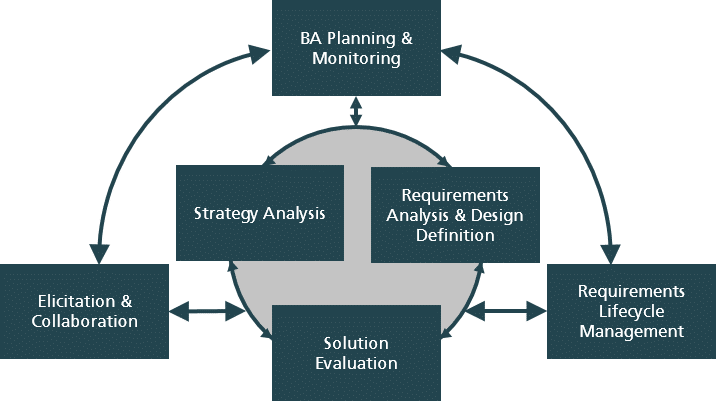Business Analysis. Find the Need, Define a Solution and Create Value.
What is business analysis? What are the advantages and what are the tasks for a business analyst?

Business analysis aims to enable change in an organization in order to create value for stakeholders. To do this, the need is identified and solutions are recommended.
Application of Business Analysis
Business analysis means solving issues. To say it more positively: You meet needs. These needs may be of any type or size. For example, an organization wants to improve a business process. Or a department has the need of a new tool in order to create their product documentation. These examples may seem easy at first glance but business analysis has to deal with a lot of questions. For instance: Is the described issue the real issue? What is the issue in reality? What kind of solutions are there and which is the best one? Has the solution actually met the need that was described and how well did it?
This means: Business analysis deals with a lot of information that you have to analyze, compare and validate. It means that you communicate with all persons involved and look at the need from all kinds of perspectives to find the best solution – and don’t forget to questions solutions you’ve found. Since business analysis comprises a wide range of methods, tasks and skills, the Business Analysis Body of Knowledge (BABOK) has been created. This guide is currently present in the third version and provides a guideline for business analysis. The International Institute of Business Analysis (IIBA), a non-profit organization with more than 28,000 members, has created it.
Advantages of the Business Analysis
Tool
to make organizations more efficient, productive and profitable
Chance
for organizations to express their needs, welcome changes and find solutions that create value for them
Pointer to the future
that ensures that the organization is on track to reaching their goals
Error Reduction
because every information is considered and compared
Improved Communication
because all people involved are talked to, allowing them to express their opinions
Customers Satisfaction
because all stakeholders and their goals are included
Business analysis definition given by the International Institute of Business Analysis (IIBA):
“Business Analysis is the practice of enabling change in an enterprise by defining needs and recommending solutions that deliver value to stakeholders.”
Business Analysis According to the BABOK v3
The BABOK defines 6 knowledge areas that the business analysis covers. In these knowledge areas, there are always tasks that you do at least once during the business analysis.
Apart from this, there are techniques that propose how to do these tasks. Additionally, the business analyst must have underlying competencies that comprise knowledge, skills, behavior, characteristics and personal traits; and finally, a business analyst may take different perspectives that result in different tasks and techniques they must do or use depending on the context.
The Business Analysis Knowledge Areas

Business Analysis Planning & Monitoring
Tasks:
- Plan business analysis approach
- Plan stakeholder engagement
- Plan business analysis governance
- Plan business analysis information management
- Plan business analysis performance improvements
Strategy Analysis
Tasks:
- Analyze current state
- Define future state
- Assess risks
- Define change strategy
Elicitation & Collaboration
Tasks:
- Prepare for elicitation
- Conduct elicitation
- Confirm elicitation results
- Communicate business analysis information
- Stakeholder engagement
Requirements Analysis & Design Definition
Tasks:
- Specify and model requirements
- Verify requirements
- Validate requirements
- Define requirements architecture
- Define design options
- Analyze potential value and recommended solutions
Requirements Lifecycle Management
Tasks:
- Trace requirements
- Maintain requirements
- Prioritize requirements
- Assess requirements changes
- Approve requirements
Solution Evaluation
Tasks:
- Measure solution performance
- Analyze performance measures
- Assess solution limitations
- Assess enterprise limitations
- Recommend actions to increase solution value
Knowledge to go
Identify needs, propose solutions and add value
with objectiF RPM
Business analysis or requirements engineering? In practice, there is sometimes a difficulty to separate the business analyst and requirements engineer terms. But they they are different. A business analyst has to do the tasks of an requirements engineer – but they must do more than that.
The business analysist not only defines requirements but also recommends solutions and has always the whole system in mind.
Perspectives in the Business Analysis
A business analyst has a lot of tasks. This is why the BABOK proposes specific perspectives or roles that limit the tasks for them. A business analyst may take the following perspectives:
- Business Intelligence: Focus on data elicitation, data modeling and data documentation
- Information Technology: Focus on developing requirements
- Business Architecture: Focus on the entire organization from a functional and organizational context
- Business Process Management: Focus on analyzing, drafting and modeling business processes
- Agile: Planning, analyzing, implementing and testing the changes (as a team member or product owner)
Techniques in the Business Analysis
Depending on the knowledge area, you can use different techniques. For instance, there are:
- Backlog Management
- Business Case
- Document analysis
- Figures and key performance indicators
- Reviews
- Risk analysis and management
- Use Cases
- User Storys
Competencies for Business Analysis
- Analysieren
- Kreativ denken
- Entscheidungen finden
- Probleme lösen
- Informationen organisieren
- Vertrauen schaffen
- Kommunizieren
- Das Ganze betrachten
- Lernen
- Verhandeln
- Zusammenarbeiten
- Leiten
Analyze
Think creatively
Find decisions
Solve issues
Organize information
Create trust
Communicate
Consider the whole system
Learn
Negotiate
Collaborate
Lead
Use Business Analysis to Create Value
As a business analyst, you can take various perspectives and have a wide range of tasks to do. But how do you document the results of your analysis? And how do you ensure traceability so that you can, for example, trace requirements to their related stakeholders? Use software that supports you in the business analysis. You have results for the strategy analysis and business needs? Just use the folder template that has been created according to BABOK. You identified requirements based on needs? Just derive them and be always on track about their state – from the definition, to the implementation and the test and finally to the approval. In this way, you can keep an eye on the whole system.

